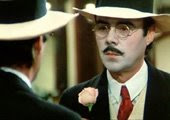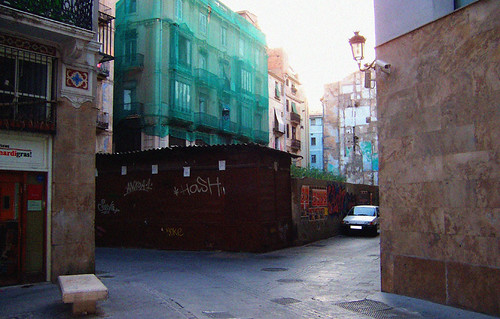Terrats de Ciutat Vlla, Santa Caterina, el Micalet. That's part of the skyline you can see from the Centre de Cultura Contemporània Octubre in València. Roofs of the Old Town, Saint Catherine and the Micalet (Cathedral Bell Tower).
Això és part del que es pot veure des del terrat del Centre de Cultura Contemporània Octubre de València (Contemporary Culture Centre in València).
Monday 30 June 2008
Flat Roof. From the Centre Octubre in València.
Sunday 22 June 2008
Kim Carnes: Bette Davis Eyes.
I like this song, Carnes' performance and Bette Davis Eyes'. Such a deep penetrating look... can one stare it?
Kim Carnes (1945,Pasadena, CA) is a Grammy Award-winning American singer-songwriter. She is noted for her distinctive, raspy voice which she attributes to many hours spent singing in smoky bars and clubs.
Carnes was a member of New Christy Minstrels in 1967. During this time, Carnes met and married Dave Ellingson with whom she would write most of her songs.
She began releasing albums during the early 1970s.
In 1981, she recorded the Jackie DeShannon and Donna Weiss song "Bette Davis Eyes", it became a worldwide hit.
Ironically, "Bette Davis Eyes", written in 1974, was originally rejected by Carnes. It was only after a new instrumental arrangement that Carnes agreed to record the song and it became a huge hit.
Bette Davis admitted to being a fan of the song. Davis wrote to Carnes after the song was released and stated that she was very pleased with the song as it made her seem very up-to-date with her grandson. She had Carnes sing the song live for her at a tribute held just before her death.
(from the wiki)
Kim Carnes (1945,Pasadena, CA) is a Grammy Award-winning American singer-songwriter. She is noted for her distinctive, raspy voice which she attributes to many hours spent singing in smoky bars and clubs.
Carnes was a member of New Christy Minstrels in 1967. During this time, Carnes met and married Dave Ellingson with whom she would write most of her songs.
She began releasing albums during the early 1970s.
In 1981, she recorded the Jackie DeShannon and Donna Weiss song "Bette Davis Eyes", it became a worldwide hit.
Ironically, "Bette Davis Eyes", written in 1974, was originally rejected by Carnes. It was only after a new instrumental arrangement that Carnes agreed to record the song and it became a huge hit.
Bette Davis admitted to being a fan of the song. Davis wrote to Carnes after the song was released and stated that she was very pleased with the song as it made her seem very up-to-date with her grandson. She had Carnes sing the song live for her at a tribute held just before her death.
(from the wiki)
Friday 13 June 2008
A corner in the old town in Valencia.
I took this picture on Januray, 2003. This is a place set in the old town near the Llotja (gothic silk market), Saint Catherine Church ant the Plaça Redona in Valencia.
Tuesday 3 June 2008
Buddha Collapsed Out of Shame.

Buddha Collapsed Out of Shame (Buda As Sharm Foru Rikht). Hana Makhmalbaf (2007).
Last Saturday I went to the cinema. I saw an impressive, touching film which shocked me. This is an interesing story full of pain and beauty. The main character is a little girl who just wants to buy a notebook and a pen to go to school but he does not live in a west country, she lives in Afghanistan. The girl is harassed by boys playing games cruelly mimicking their violent society. The boys want to stone Baktay (the child) or destroy her like the Buddha or shoot her like the Americans do in the labyrinth of caves. Will Baktay be able to overcome these obstacles in order to learn the alphabets of her mother tongue?
The film is a poetic and frightening journey into the minds of the children who live in the desolate area where the Talibans’s destruction of cultural treasures sickened the world – and children affected by violence everywhere. The story is a reflection of war and the seemingly unbreakable cycle of violence in children.
Since the cute little Baktay serves as the narrative guide on this journey, it is very easy for the viewers to empathize with her aspirations and disappointments, despite the very basic dialogue. The purity of the child and her struggles illustrate the very core of Afghanistan's problems and challenges, as the audience experiences first-hand the ruthlessness of the Taliban via the boys' war game.
Very common for Makhmalbaf, is the neo-realist style of filmmaking, with simple and naturalistic portrayal of events, handheld cameras and non-actors in leading roles. However, the main story is told symbolically through the specific surroundings, the games characters play, the clothes they wear—all of these, plus the music, accentuating the climactic moments of the film, guide us on this colorful but devastating journey to the Middle East.

The film feels extremely authentic, but this is not a documentary. Through the eyes of the child the film sneakily reveals all sorts of narrative surprises and political critiques despite its simple exterior. And, as custom dictates in this kind of film, the little girl is almost too cute for words, evoking gushes of sympathy toward her numerous trials.
The film’s title comes from Hana’s (Hana Makhmalbaf, the director) father. According to her, Mohsen meant that “even a statue can be ashamed of witnessing all this violence and harshness happening to these innocent people and, therefore, collapse.” Shots of the looming emptiness in the Bamian cliff faces that once housed these serene Buddhas are indeed among the film’s most devastating moments.
Hana’s done a brave and intelligent work and only with 19 years old. A brilliant poetic story against violence, intolerance and in defence of culture as the tool for tolerance peace and freedom, for a better world.

Subscribe to:
Posts (Atom)







